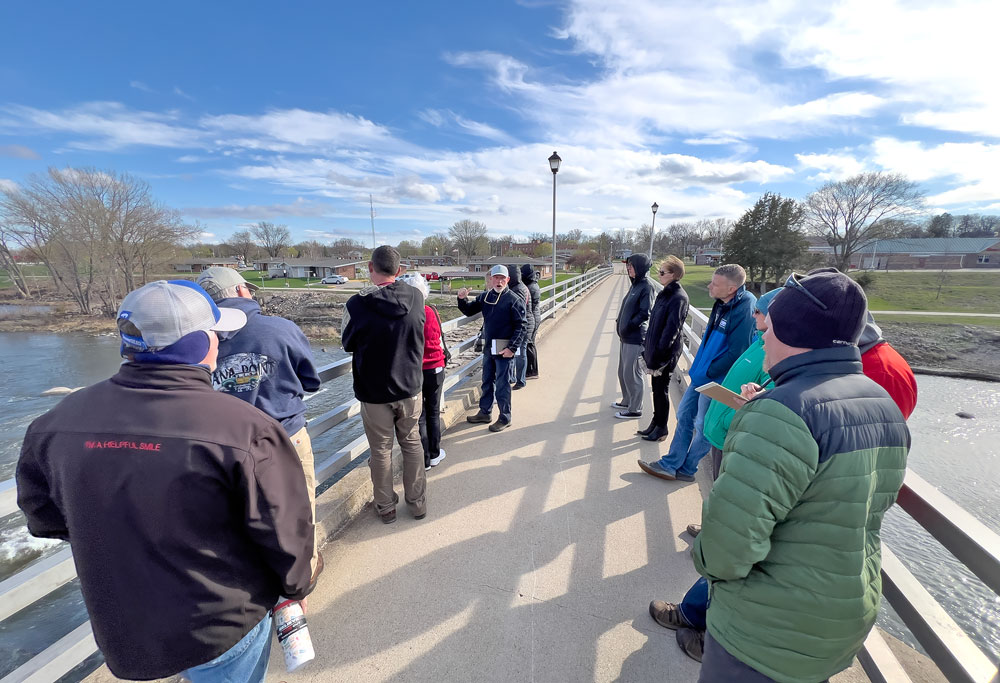Forum on cap and trade is hosted by T.E.A. Party
By MARY ALICE MURPHY
Special to the Press
A forum on cap and trade, to discuss impacts of the congressional effort to expand regulations on the energy industry, was held at the Western New Mexico University Global Resource Center on Wednesday evening. H.R. 2454, commonly known as the Waxman-Markey or cap-and-trade bill, was passed by the U.S. House of Representatives this summer.
The Taxed Enough Already Party, a bipartisan group that has formed to protest expanded government control of health care and energy, sponsored the forum.
Panelists included representatives of industry and academia, and an accountant. Mike Rowse of KSCQ moderated the event.
Brent Hines, a third-year student at WNMU, gave his perspective of how the almost 1,500-page bill, if it passes the Senate and is signed by the president, will impact his generation.
Nick Contor, representing the building industry, said he is a supporter of “green’ building, but believes the bill will adversely impact construction because energy costs are a large part of the price of building materials.
Pat O’Connell, PNM representative, said he has studied how greenhouse gas regulation will impact the energy industry. PNM supports the federal initiative, because it recognizes that some regulation will occur and the company believes cap-and-trade legislation is more evenhanded. John Cunningham, WNMU geology professor emeritus, presented his ideas on climate change.
Mike Morones, certified public accountant at Morones and Knuttinen LLC, said his interest in the legislation is the cost and benefits. He made it clear that there will be a cost of action or inaction.
Tom Bosworth, a retired FordMotor Co. automotive engineer, talked about regulation of the auto industry.
John Paul Jones, representing Porter Oil Co., said the legislation would directly impact his operation as a fossil fuels distributor, and would likely drive many manufacturing jobs offshore.
Jack Byrne of Trout Valley Enterprises, an international oil and gas firm, said the legislation proposes replacing the use of fossil fuels but has not named a replacement energy source.
The first question from a Grant County resident pointed out that breathing produces carbon dioxide, which has been deemed a poisonous gas.
Bosworth said the U.S. Supreme Court ruled that the Environmental Protection Agency could regulate CO2 as a pollutant.
“There will be regulations whether or not cap and trade is passed,’ Bosworth said.
Cunningham said that CO2 is essential for plants, and that the world without plants will be in “even more trouble.’
A resident pointed out it would cost a great deal to replace the infrastructure now in place if fossil fuels are replaced, and asked how much energy costs would rise for the average consumer.
O’Connell said the reason PNM supports the federalregulation is that a nationwide effort is needed to achieve the goals set forth in the legislation.
“It will buy us time, but there is not a clear indication of what will replace coal, which is the primary fuel used to create electricity,’ O’Connell said. “Replacing infrastructure doesn’t happen for free. Some folks say cap and trade will save money; others say it will raise costs by an average of $1,000 per family per year.’
He said the bill has many consumer protections, including a rebate for lowincome families.
Byrne pointed out that the president when he was on the campaign trail said “cap and trade will send electric rates through the ceiling.’
According to Byrne, the Heritage Foundation, a conservative think tank, estimates costs could rise as much as 90 percent.
Hines said a so-called energy stamp or rebate program for low-income households will become the country’s largest welfare program, with rebates going to as many as 65 million people.
“Twenty percent of Medicare claims are fraudulent,’ Hines said. “Money will go out as rebates for energy costs, but
FORUM Page 6B
From Page 1
will it be used for the right purposes?’
Contor said Europe has been under cap- and- trade regulation since 2005.
“In Germany, utility costs have risen by 25 percent, and the effect has been to reduce work hours and the work force. CO2 emissions actually rose by 2 percent. If it’s not working there, why would it work here?’
Morones said energy cost increases are a regressive tax on the poor.
“According to Peter Orzag, the president’s budget director, the lowest-income households will see energy costing 3.3 percent more of their after-tax dollars,’ Morones said. “In middle-income households, the increase will take 2.7 to 2.9 percent of after-tax dollars; and the highest earners will spend 1.7 percent more.’
Cunningham said evidence of climate change over the past 2.2 billion years shows that it has been “hotter, colder, wetter and drier’ than now.
O’Connell said the European model is not a goodmodel because the emissions estimates to which the current estimates compare include the former Soviet bloc countries.
“Acid rain regulation is a better comparison,’ O’Connell said. “It greatly reduced sulfur dioxide emissions.
“The discussion is about removing CO2 from the atmosphere,’ he continued. “There is some regulation on the way. The most flexible and least impacting regulation is the federal bill.’
Jones read from a Washington Post article by Martin Feldstein that estimated that a 15 percent reduction in CO2 would cost the average consumer about $1,600 a year.
“Americans should ask if that is justified,’ Jones said. “The U.S now produces 25 percent of CO2, but as China’s and India’s industry grows, that percentage will decrease and there will be less than a 4 percent reduction in CO2. Let’s wait until China and India are on board.’
Contor alleged that a disconnect exists between a comparison of cap and trade and acid rain regulation, because low-sulfur fuels were available when the sulfur dioxide regulation went into effect.
A county resident, who said he once worked at a nuclear power plant, said nuclear fuel has no CO2 emissions. He has read that 1.5 million jobs will be lost by 2035 if cap and trade is passed.
“The only choice is nuclear,’ he said. “If China and India don’t do anything it will negate what we do.’
O’Connell said it take about eight years just to construct a nuclear power plant.
“The Senate is evidently leaning toward nuclear energy,’ he said.
The industry is researching the possibility of smaller nuclear plants that could go online more quickly.
“It seems everyone is convinced that CO2 is the culprit,’ Cunningham said. “Ice cores show that when the temperature rises, then CO2 goes up. Cold water holds more CO2. When it warms up, CO2 is released.’
An area resident asked about the Breeder Reactor, which was fueled by fusion, and pointed out that France has three times the number of nuclear reactors as the U.S., and sells its surplus energy to other countries.
Byrne said the government continues to fund cold fusion research, but at a low $1.2 billion a year. He also pointed out that the government dropped funding for Yucca Mountain, where nuclear waste was approved to be dumped.
Bosworth said the auto industry has been receptive to what consumers want.
“The first thing the industry did to reduce emissions was making smaller the holes in the ‘tomato cans’ we called carburetors,’ he said. “In 1975, we thought we were going to close the doors (of the company) because we couldn’t meet federal requirements, but the catalytic converter was invented just prior. Today most research is going toward direct fuel injection into the combustion chamber.’
He said new cars have much less emission, and “I know how much better they are. I also don’t think most Americans are behind global warming, until we have a national debate.’
“American industry will do what the consumer wants, but you have to pay for it and give us time to do it,’ Bosworth said. “Electric vehicles will continueto improve.’ Bill VanDran said he prefers having engineers, not utopians,building his bridges. “The elephant in the room is that we have no impact on emissions,’ he alleged. “The world population is estimated to increase to nine billion by 2050. Most of the extra three billion will be beyond U.S. regulation, because they will be in developing countries, and they will want autos, computers and washing machines. There may be a slight increase in electricity usage here, but way up in othercountries.’ Cunningham said the latest climatic change globally was the Little Ice Age in the1300s. “We’re still coming out of it,’ he said. “The Medieval Warm Period was warmer than now. I think warming is not as big a danger as cooling. We’re probably in an interglacialperiod.’ During the Fourth Glaciation, he said, a sheet of ice 2 1/2 miles thick lay over Canada and half the U.S., as well asmost of Europe. Hines said cheaper sources of fuel will be found, then prices of them will rise as theyare used more. As for the trade of emission credits, “big investors will purchase extra credit. When they meet their cap, they will get the credits from others,’ Hinessaid. B osworth replied to a question about the rising price of electricity, fuel and engineering if the bill passes andbecomes law. “Those will rise, but manufacturing will not, because once corporations meet their limit and cannot charge for credits, they will move to China andIndia,’ he said. An audience member asked, if people cannot afford health insurance, how would they be able to afford a rise inutility costs.
Hines said a $50 increase in an electric bill would be ahardship for many. “It is predicted that there will be a decrease of $9.4 trillion in the gross domestic product,’ Hines said. “Electricity costs will go up 90 percent and gasoline 58 percent. Silver City, being away from cities, alreadypays 15 percent more.’ Byrne alleged that the government is “not a benevolent nanny, but it’s a question of control. They’re not interested in how much more you haveto pay.’ O’Connell answered more fully why PNM supports thefederal legislation. “ The cap will reduce emissions and creates incentives to reduce CO2,’ he said. “It should help contain costs. The EPA has already started endangerment funding, saying that CO2 is endangering the environment. The only thing to stop the EPA process is federal legislation. The EPAis not flexible.’ He also cited the Western Climate Initiative, whose members include several Western states and a few Canadianprovinces. “Think about how small an area it is,’ O’Connell said. “There is less opportunity foradvantages.’ He said the New Mexico Environment Department Environmental Improvement Board has proposed a cap,with no trade. “It is tied to a 20 percent reduction in emissions from a 1990s date,’ O’Connell said. “The federal bill is the mostpalatable.’ A resident pointed out that with no replacement for fossil fuels in the legislation, solar and wind power are not continuousand require storage. Bosworth said the closest possibility for replacing fossilfuels is nuclear power. “We’re legislating from politics, not science,’ he said. “The U.S. uses 98.2 quadrillion BTUs of energy. Assuming wind will blow when the grid can take the energy, it will take 17.6 million windmills to make two percent of that amount.’
Cunningham said solar cells do not heat up the atmosphere, but cool it down.
“It only heats up when it reflects back,’ he said. “Cooling could lead to anotherglaciation.’ Contor pointed out that in the construction industry, “different solutions are needed indifferent regions.’ “For instance, here we can use solar energy created with solar cells or passive solar,’ Contor said. “But the problem comes when requirements of building materials become more efficient, it reduces the solar gain. I see a need for more individualize energychoices and approaches.’ A resident asked if it were true that electric cars would create more carbon emissions because of a need for more coal burning to create the electricity. She also asked for an update onethanol usage. According to Bosworth, a plug-in car would use electricity at night, when more electricity is available.
O’Connell said it would depend on where one lives.
“ In New Mexico, it is possible that coal would be the source of power,’ he said. “In other parts of the country, it may be nuclear-based orhydropower.’ Byrne said “the dirty little secret of ethanol’ is the costand the benefit. If a gallon of ethanol costs $1 and a gallon of gasoline costs $1, “you’re buying the energy potential of BTUs in combustion. The gallon of gas gives you 115,000 BTUs, while the ethanol gives you 75,000. The 10 percent emission reduction in ethanol actually causes an increase in volatile organic compounds. Ethanol ain’t theanswer.’ A Cliff resident asked if wood burning would be allowed and about the price of butane if cap and trade passes. Byrne said he saw nothing in the bill that addresses wood burning, “because they don’t burn wood in Washington, D.C.’ Those under certain income levels will receive subsidies. “Where are they going to get the money? They’re goingto tax the rich.’ A county resident alleged that the proposed legislation is about control. He mentioned Agenda 21, which according to a United Nations Department of Economic and Social Affairs Division for Sustainable Development Web site, “is a comprehensive plan of action to be taken globally, nationally and locally by organizations of the United Nations System, governments, and major groups in every area in which human impacts on the environment.’
A woman, who identified herself as a resident of Seattle, said the amount of CO2 “dumped into the atmosphere when Mount St. Helen’s blew equaled as much as people putinto the air in 10 years.’Cunningham said the volcano also spewed water vaporand sulfur gases. Another resident asked about the amount of CO2 in controlled burns and said she doesn’t believe the concern isreally about CO2. At the end, Jones said if the fuel source is changed, “my product becomes untenable. Will I be able to change and what about my employees? It’s an interesting dilemma.’







Social Share